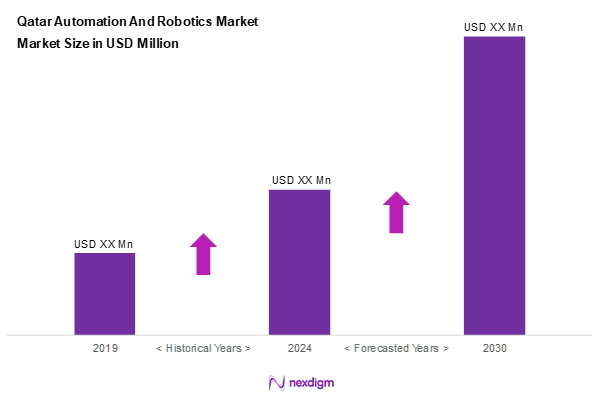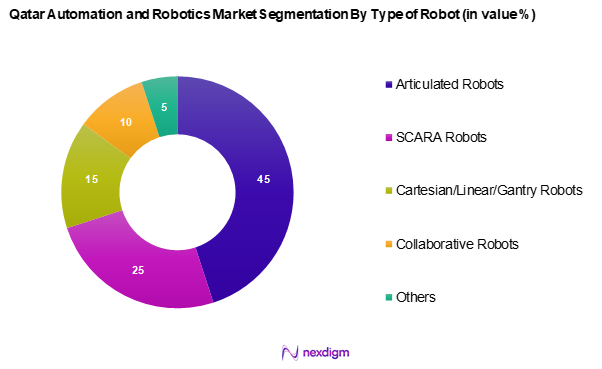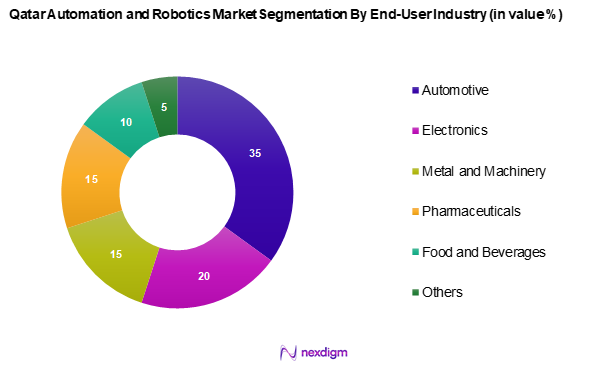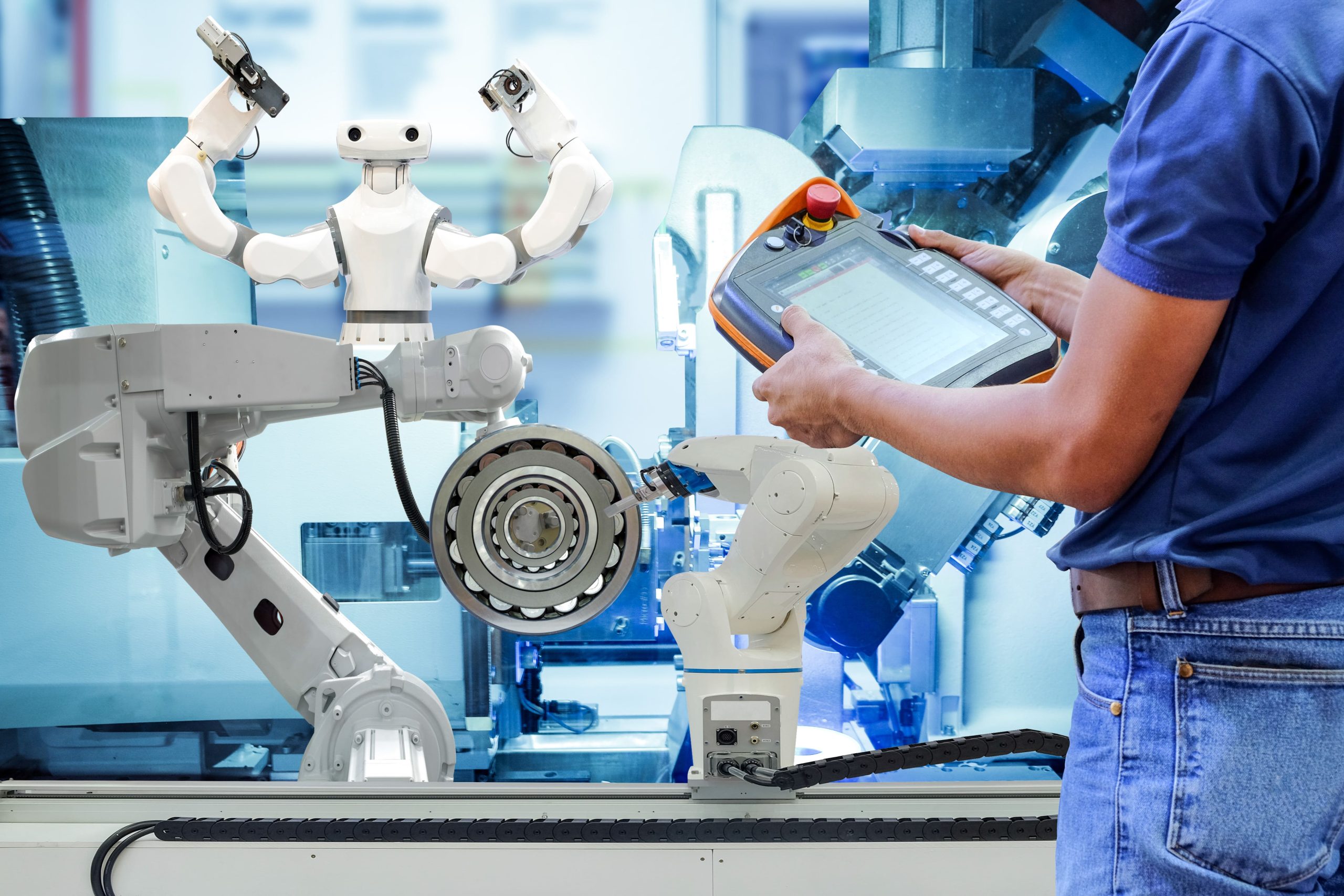Market Overview
As of 2024, the Qatar automation and robotics in manufacturing market is valued at USD 47.5 million, with a growing CAGR of 7.4% from 2024 to 2030, reflecting its robust expansion driven by increasing investments in advanced manufacturing technologies and a growing focus on efficiency in production processes. Enhanced productivity and precision in manufacturing operations have spurred the adoption of automation and robotics solutions, reshaping the industrial landscape in Qatar.
Dominant cities like Doha, Al Rayyan, and Al Wakrah play a pivotal role in the market due to their strategic location, thriving industrial sectors, and government support for technological advancements. The Qatari government’s initiatives, such as Vision 2030, are focused on modernizing the economy, which further supports the growth of automation and robotics in these urban areas.

Market Segmentation
By Type of Robot
The Qatar automation and robotics market is segmented into articulated robots, SCARA robots, Cartesian / linear / gantry robots, collaborative robots, and others. Articulated robots hold a significant market share due to their versatility and ability to perform complex tasks, making them ideal for various applications in manufacturing sectors. Their design allows for greater flexibility and precision, which is crucial for specific tasks like welding, assembly, and material handling, leading to their dominance in the market.

By End-User Industry
The Qatar automation and robotics market is segmented into automotive, electronics, metal and machinery, pharmaceuticals, food and beverages, and others. The automotive industry takes the lead in market share as a primary user of automation and robotics technologies for processes such as assembly lines and quality control. The industry’s constant need for increased efficiency and speed in production drives significant investment in robotic solutions, securing its status as the dominant segment.

Competitive Landscape
The Qatar automation and robotics market is highly competitive, featuring key players like ABB Ltd., Siemens AG, Rockwell Automation, Fanuc Corp, and Kuka AG. These companies leverage their technological expertise and global reach to establish a strong presence in the market, innovating continuously to maintain competitive advantages. The consolidation of major corporations underscores their significant influence and ability to drive market trends.
| Company | Establishment Year | Headquarters | Product
Range |
Market
Focus |
Revenue
(USD Mn) |
Market Share |
| ABB Ltd. | 1988 | Zurich, Switzerland | – | – | – | – |
| Siemens AG | 1847 | Munich, Germany | – | – | – | – |
| Rockwell Automation | 1903 | Wisconsin, USA | – | – | – | – |
| Fanuc Corp | 1972 | Yamanashi, Japan | – | – | – | – |
| Kuka AG | 1898 | Augsburg, Germany | – | – | – | – |

Qatar Electronics Manufacturing Market Analysis
Growth Drivers
Accelerating Urbanization
Qatar is witnessing rapid urban growth, marked by a continuous movement of the population towards urban areas. This urban expansion is cultivating increased demand for electronics in city-centric sectors such as transport, infrastructure, and consumer lifestyle. The growing focus on smart city development further amplifies the need for advanced electronic systems. As more citizens adopt tech-integrated living, manufacturers are motivated to enhance local production capabilities to cater to evolving consumer needs, making urbanization a strong catalyst for market growth.
Digital Economy Push Through Government Initiatives
National strategies aimed at building a robust digital economy are acting as a powerful driver for the electronics manufacturing industry. The government’s investments in digital transformation — including better internet connectivity, improved e-services, and support for tech startups — are laying the foundation for a technology-driven ecosystem. These initiatives encourage innovation, attract global partnerships, and elevate the demand for high-tech electronics, thereby reinforcing the need for localized manufacturing to meet the growing technological requirements of both public and private sectors.
Market Challenges
Ongoing Supply Chain Disruptions
Global supply chain instability continues to affect electronics manufacturing in Qatar. Delays in sourcing critical components especially those reliant on international suppliers have strained production schedules and elevated operational risks. Geopolitical uncertainties and pandemic-induced backlogs have further intensified these disruptions, leading to inefficiencies and limiting the capacity of local firms to respond swiftly to market demands.
Rising Production Costs
Manufacturers in Qatar face mounting operational costs, with labour and raw materials becoming increasingly expensive. Inflationary trends and global fluctuations in the prices of essential electronic components are putting pressure on production budgets. These cost challenges can hinder profit margins and reduce the competitiveness of local manufacturers compared to their international counterparts, especially in price-sensitive segments.
Opportunities
Growth in Renewable Energy Technology
The national pivot toward sustainability is creating new pathways for electronics manufacturers. With growing investments in renewable energy initiatives, there is an increasing demand for electronic products used in solar systems, energy storage, and smart grid management. This transition encourages the development and production of specialized electronic components, fostering innovation and positioning Qatar as a contributor to green technology solutions.
Increased Adoption of IoT and Smart Systems
The expanding use of IoT-based technologies across various sectors presents a major growth opportunity for electronics manufacturing. From smart homes and transportation to healthcare and industrial automation, the need for connected, intelligent electronic devices is surging. This shift towards real-time data, automation, and smart infrastructure is prompting manufacturers to align their production capabilities with the growing appetite for IoT-enabled solutions, strengthening Qatar’s presence in the global tech landscape.
Future Outlook
Over the next five years, the Qatar automation and robotics market is poised for significant growth, driven by ongoing advancements in technology, increased adoption of smart manufacturing solutions, and favorable government initiatives. The growing emphasis on efficiency, productivity, and precision within the manufacturing sector will propel the integration of robotics and automation technologies, positioning the market for robust expansion.
Major Players
- ABB Ltd.
- Siemens AG
- Rockwell Automation
- Fanuc Corp
- Kuka AG
- Mitsubishi Electric Corporation
- Kawasaki Heavy Industries Ltd.
- Omron Corporation
- Stäubli International AG
- Denso Corporation
- Universal Robots
- Epson Robots
- Techman Robots
Key Target Audience
- Industrial Manufacturers
- Automation Technology Providers
- Investments and Venture Capitalist Firms
- Government and Regulatory Bodies (e.g., Qatar Financial Centre)
- SMEs in Manufacturing
- Logistics and Supply Chain Companies
- Research and Development Organizations
- Construction and Engineering Firms
Research Methodology
Step 1: Identification of Key Variables
This initial phase involves creating an ecosystem map that includes all major stakeholders in the Qatar automation and robotics market. Comprehensive data is collected from secondary and proprietary databases, aimed at defining critical variables that influence the market dynamics.
Step 2: Market Analysis and Construction
In this phase, historical data pertaining to the Qatar automation and robotics market is compiled and analyzed. This includes assessing market penetration rates, the ratio of technology adoption in different sectors, and resultant revenue generation. An evaluation of service quality metrics also supports the reliability and accuracy of revenue estimates, ensuring a comprehensive view of the market landscape.
Step 3: Hypothesis Validation and Expert Consultation
Hypotheses regarding market trends and dynamics will be developed and validated through comprehensive interviews with industry experts, utilizing methods such as computer-assisted telephone interviews (CATIs). This will involve a diverse array of participants from major companies within the sector, all of whom can provide insights that refine and corroborate the data collected.
Step 4: Research Synthesis and Final Output
The final phase consists of direct engagement with multiple automation and robotics manufacturers in Qatar. This engagement will yield detailed insights into specific product segments, sales performance, consumer preferences, and other pertinent market factors. The information gathered will serve to verify and complement statistics drawn from the previous phases, ensuring a thorough and validated analysis of the market.
- Executive Summary
- Research Methodology
(Market Definitions and Assumptions, Abbreviations, Market Sizing Approach, Consolidated Research Approach, In-Depth Industry Interviews, Primary Research Approach)
- Definition and Scope
- Market Genesis
- Timeline of Major Players
- Business Cycle
- Supply Chain & Value Chain Analysis
- Growth Drivers
Increased Demand for Precision
Integration of IoT in Robotics - Market Challenges
High Initial Costs
Technical Skill Gap - Opportunities
Expansion in SMEs
Customized Solutions - Industry Trends
Rising Adoption of Cobots
Automation in SMEs - Regulatory Framework
Labor Laws
Safety Standards - SWOT Analysis
- Stakeholder Ecosystem
- Porter’s Five Forces Analysis
- By Value, 2019-2024
- By Volume, 2019-2024
- By Average Price, 2019-2024
- By Type of Robot (In Value %)
Articulated Robots
– 4-axis Robots
– 6-axis Robots
– Heavy-Duty Industrial Robots
SCARA Robots
– Pick-and-Place SCARA
– Small Parts Assembly SCARA
Cartesian/Linear/Gantry Robots
– Single-Axis
– Multi-Axis
– Gantry Configurations for CNC/3D Printing
Collaborative Robots (Cobots)
– Light Assembly Cobots
– Medical Cobots
– Packaging Cobots
Others
– Delta Robots
– Cylindrical Robots
– Hybrid Robotic Systems - By End-User Industry (In Value %)
Automotive
– Welding & Painting Automation
– EV Component Assembly
Electronics
– Microchip Placement
– PCB Soldering
Metal and Machinery
– CNC Automation
– Cutting & Forming Automation
Pharmaceuticals
– Cleanroom Robots
– Precision Dispensing & Packaging
Food and Beverages
– Robotic Packaging Lines
– Sorting & Quality Control
Others
– Logistics & Warehousing
– Utilities and Energy - By Application (In Value %)
Assembly
– Micro-assembly
– Heavy Component Assembly
Material Handling
– Palletizing/Depalletizing
– Pick-and-Place Systems
Dispensing
– Glue/Sealant Dispensing
– Pharmaceutical Dispensing
Welding
– Arc Welding
– Spot Welding
Others
– Inspection and Testing
– Surface Treatment - By Technology (In Value %)
Machine Learning & AI
– Predictive Maintenance
– Adaptive Task Programming
Vision Systems
– 2D/3D Vision for Quality Inspection
– Object Recognition
Force Sensing
– Torque Feedback Systems
– Adaptive Gripping Solutions
Others
– Digital Twins
– Wireless Integration Technologies - By Deployment Mode (In Value %)
Cloud-Based
– Centralized Monitoring Platforms
– AI-driven Robotic Process Control
On-Premise
– Localized High-Security Control Systems
– Offline Industrial Controllers - By Mode of Automation (In Value %)
Fully-Automation
– Lights-Out Manufacturing
– End-to-End Robotic Assembly
Semi-Automation
– Human-Robot Collaboration
– Operator-Assisted Robotic Tasks - By Region (In Value %)
Doha
Al Rayyan
Al Wakrah
Others
- Market Share of Major Players on the Basis of Value/Volume, 2024
Market Share of Major Players by Type of Robot Segment, 2024 - Cross Comparison Parameters (Company Overview, Business Strategies, Recent Developments, Strengths, Weaknesses, Revenue, Market Positioning, Technological Geographies, Partnerships and Collaborations, Product Portfolio, Strategic Outlook)
- SWOT Analysis of Major Players
- Pricing Analysis Basis SKUs for Major Players
- Detailed Profiles of Major Companies
ABB Ltd.
Siemens AG
Rockwell Automation
Fanuc Corp
Kuka AG
Mitsubishi Electric Corporation
Kawasaki Heavy Industries Ltd.
Omron Corporation
Stäubli International AG
Denso Corporation
Universal Robots
Epson Robots
Techman Robot
- Market Demand and Utilization
- Adoption Rate by Industry
- Investment Patterns
- Industry-specific Challenges
- By Value, 2025-2030
- By Volume, 2025-2030
- By Average Price, 2025-2030


